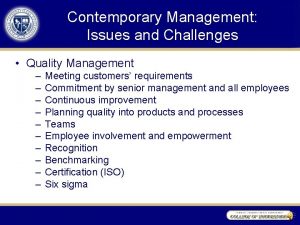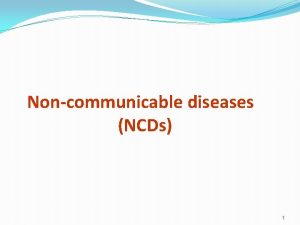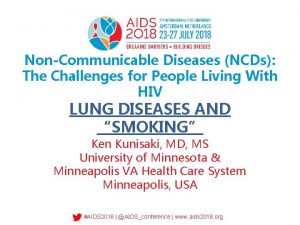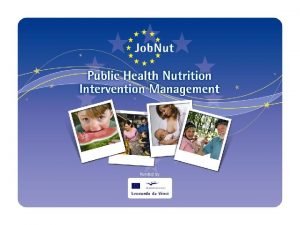Call to action on NCDs Challenges and Way
































- Slides: 32

Call to action on NCDs: Challenges and Way Forward for Maternal and Child Health Dr. Niloufer Sultan Ali Professor, Family Medicine Aga Khan University, Karachi 1

‘Each year, millions of women & children die from preventable causes. These are not mere statistics. They are people with names & faces. Their suffering is unacceptable in the 21 st century’, Ban Ki-moon, United Nations Secretary-General 2

A neglected dimension of women’s health NCDs are the world’s number one killer • 35 million people die every year 18 million are women NCDs represent the biggest threat to women’s health worldwide 3

WHO report 2008 4

Total deaths around the world: 58 million Deaths from NCDs: 35 million Deaths from NCDs in developing countries: 28 million Countdown to 2015, Maternal Child and Newborn survival, the 2012 report 5

Urgent priority for women’s health NCDs are no longer diseases of the rich and elderly Increasingly impacting on women in developing countries during the prime of their life 6

Source: WHO Chronic Disease Report, 2005 7

Ratio of Non-Communicable/ Communicable Deaths, India, China, Other Asia-Pacific, 1990 -2020 Deaths due to NCDs are 3 times more as compared to communicable diseases in Asia Pacific Source: WHO Chronic Disease Report, 2005 8

NCD Diseases 4 Diseases, 4 Modifiable Shared Risk Factors Tobacco Use Unhealthy diets Physical Inactivity Harmful Use of Alcohol Cardiovascular Diabetes Cancer Chronic Respiratory Source: WHO Chronic Disease Report, 2005 9

NCD in Pakistan WHO report 2008 10

NCD in Pakistan…Cont WHO report 2008 11

IMPACT OF NCDs macro-economic impact Lost National Income Lost national income from premature deaths due to heart disease, stroke and diabetes 2005 2006 -2015 (cumulative) Lost national income (billions) Brazil 3 49 China 18 558 India 9 237 0. 4 8 Pakistan 1 31 Russian Federation 11 303 Tanzania 0. 1 3 Countries Nigeria Source: WHO Chronic Disease Report, 2005 12

Women & Diabetes • Currently, 143 million women are suffering from diabetes • By 2030, this number is expected to rise to 222 million • Diabetes is the ninth leading cause of death in women globally • Gestational diabetes develops in one in 25 pregnancies worldwide. Source: WHO Chronic Disease Report, 2005 Source: Countdown to 2015, Maternal Child and Newborn survival, the 2012 report 13

Women & Cancer • Over 3 million women die of cancer each year • Breast & lung cancers are the most common cancer killers of women • An estimated 1. 7 million women will be diagnosed with breast cancer in 2020—a 26% increase from current levels—mostly in the developing world Source: WHO Chronic Disease Report, 2005 14

Women & CVD • CVD is the number one killer of women worldwide • Causes 9. 1 million deaths among women annually • In 2008, CVD killed 1. 2 million women aged between (20 -59 years) the most productive years of life • Developing countries are more affected Source: WHO Chronic Disease Report, 2005 15

Offspring CVD Risk by Parental CVD Status: Framingham Study Parental CVD Risk Ratio <55 men, <65 Women 2. 5 2 2. 2 1. 5 1. 7 1 1. 0 0. 5 0 Male offspring 1. 0 Female offspring Source: International Society of Hypertension 16

NCDs in women compromises child health NCDs not only affect the health of women but also the health of their children • Being born to a malnourished mother increases the chances of the infant suffering from under-nutrition, late physical and cognitive development and NCDs in adulthood 17

Childhood Obesity • 43 million children under five years are overweight • Girls are more likely to be overweight > Restrained from regular physical activity and sport >Lack of safe and supportive environments 18

Source: The Growth Assessment and Surveillance Unit, Department of Nutrition for Health and Development, World Health Organization, Geneva, Switzerland. 19

Current Challenges & Barriers to Women’s Health 20

Socio-cultural Barriers Women Education & Empowerment – Young women & girls are unable to make decisions about care for themselves or for their children without the permission of their husbands – Higher rates of illiteracy among women results in less access to information about NCD risk factors, prevention & treatment 21

Health System Barriers • Women are less likely to seek medical care from male health providers due to cultural taboos • Shortage of female health care providers • Lack of NCD component in existing health systems 22

Health System In Pakistan Source: WHO, country profile 2008 23

A Way Forward 24

Fight for NCDs Reduce modifiable risk factors among individuals & populations • Tobacco use • Unhealthy diet • Physical inactivity • Harmful use of alcohol 25

A CALL FOR ACTION We need to move away from the fragmented approach to health and move towards taking a holistic view of the health of girls and women 26

A call for Action…Cont • Enhance women education and empowerment • NCD component to be integrated into existing health systems • Link information of NCDs to reproductive health programs • Involvement of women in identifying problems, solutions & implementing policies in the fight against NCDs 27

We can act TOGETHER, LET’S MAKE NCDs A PRIORITY FOR WOMEN’S HEALTH AND DEVELOPMENT 28

Act now on NCDs for girls, women and future generations 29

We all have a role to play Everyone has a critical role to play in improving the health of women and children 30

Role of Family Physicians • • • Promote healthy lifestyle Provide opportunistic care Share information regarding NCDs Address modifiable risk factors Conduct public awareness sessions Emphasize on regular check-ups 31

Thank You
 Reverse covered call
Reverse covered call What is options
What is options Gartner magic quadrant call recording
Gartner magic quadrant call recording What's a frequency table
What's a frequency table Advantages and disadvantages of threaded binary tree
Advantages and disadvantages of threaded binary tree Perbedaan one way dan two way anova
Perbedaan one way dan two way anova Conventional software engineering
Conventional software engineering Problem and solution paragraphs
Problem and solution paragraphs Call to action in an essay
Call to action in an essay What is a conclusion in a persuasive essay
What is a conclusion in a persuasive essay Call to action in an essay
Call to action in an essay Free call to action templates
Free call to action templates Call to action bms
Call to action bms Two way anova
Two way anova One way two way anova
One way two way anova One way anova vs two way anova
One way anova vs two way anova Contoh soal two way anova
Contoh soal two way anova When i was one i had just begun the day i went to sea
When i was one i had just begun the day i went to sea Talk this way
Talk this way Climax graphic organizer
Climax graphic organizer The lion and the fox exposition
The lion and the fox exposition What are plot stages
What are plot stages The black cat exposition
The black cat exposition Suit the action to the word the word to the action meaning
Suit the action to the word the word to the action meaning What are the opportunities in informational
What are the opportunities in informational Topic 7 economic performance and challenges
Topic 7 economic performance and challenges 3 filipino adolescent heroes
3 filipino adolescent heroes Advantages and challenges of multigrade teaching
Advantages and challenges of multigrade teaching What are contemporary management issues
What are contemporary management issues Mainframe vs cloud
Mainframe vs cloud Challenges of service innovation and design
Challenges of service innovation and design Managing diversity and regulatory challenges
Managing diversity and regulatory challenges Ihrm trends and future challenges
Ihrm trends and future challenges






















































